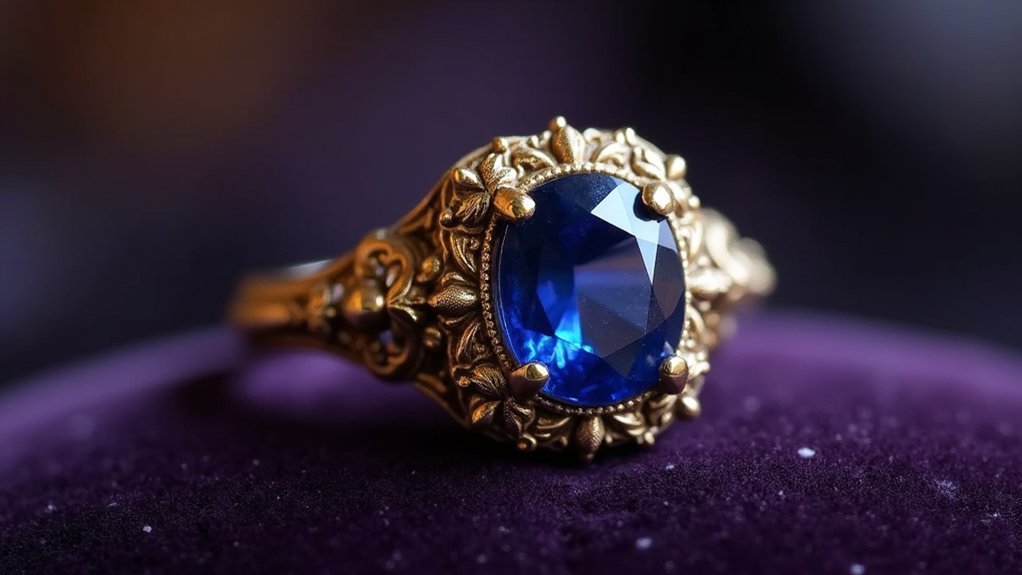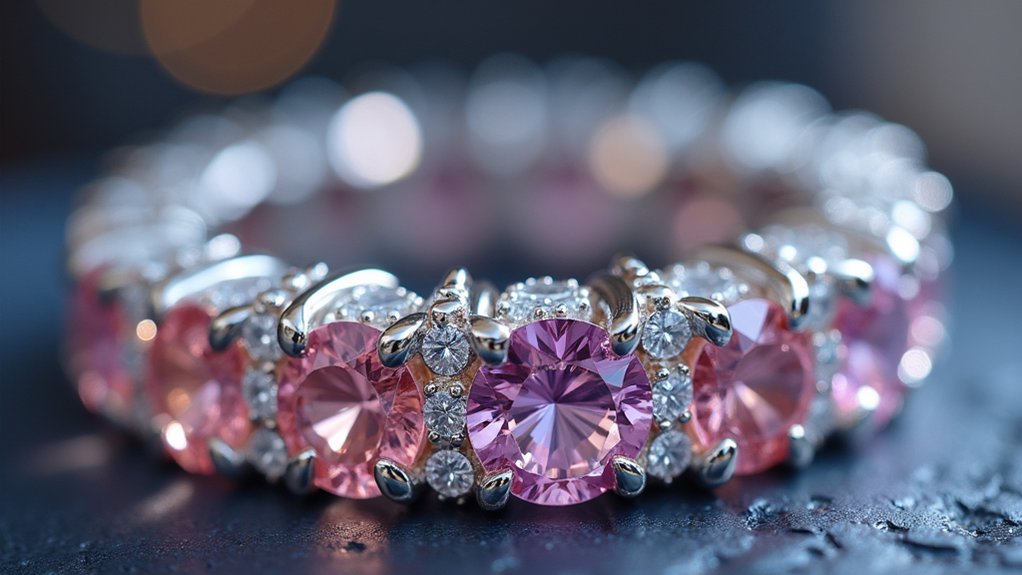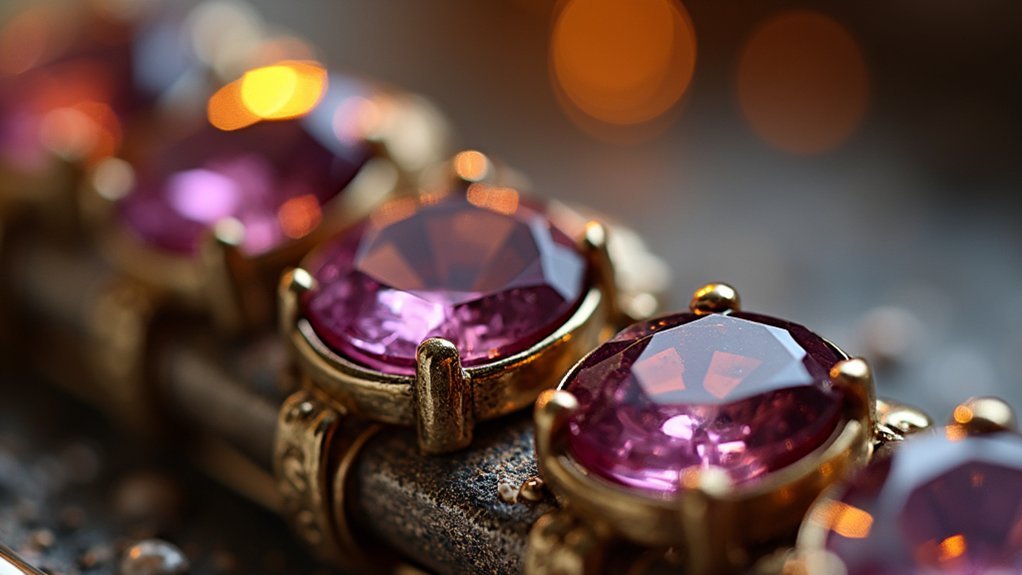Traditional gemstone mounting techniques include prong settings that use metal claws to secure stones while maximizing light exposure, bezel settings that create protective metal rims around gemstones, and channel settings that align stones flush between metal bars. You’ll also find pavé settings using tiny prongs for seamless sparkle effects, tension settings that grip stones through metal pressure, and flush settings that embed gems directly into metal surfaces. Each technique offers unique benefits for security, aesthetics, and protection that we’ll explore further.
Historical Origins of Gemstone Mounting Craftsmanship

While ancient civilizations developed numerous artistic traditions, gemstone mounting stands out as one of humanity’s most enduring crafts. Egyptian artisans created the earliest known examples around 3000 BC through simple stringing and drilling methods.
You’ll find that Greeks revolutionized jewelry making by introducing metal frames, developing sophisticated bezel settings and prong settings during the Hellenistic period.
Medieval European goldsmiths enhanced setting techniques by incorporating religious symbolism into their metalwork designs.
The Renaissance period marked a pivotal transformation in these historical origins, as artisans emphasized naturalism and realism. This era introduced advanced methods like pave and cluster settings, fundamentally changing how you’d approach gemstone mounting and establishing foundations for modern techniques still used today.
Prong Setting Fundamentals and Applications
Among all the Renaissance innovations that transformed gemstone mounting, prong setting emerged as the most revolutionary technique and remains today’s most widely adopted method for securing precious stones.
You’ll find this setting style uses three, four, or six metal claws that bend around your gemstone’s girdle to hold it securely while maximizing light exposure, enhancing its brilliance from multiple angles.
This versatile technique accommodates various stone shapes and sizes, making it perfect for engagement rings and fine jewelry piece designs.
You can craft prongs from:
- Gold – offers warmth and traditional appeal
- Platinum – provides superior durability and strength
- Silver – delivers affordability with elegant aesthetics
Remember that prong settings require regular maintenance since loose prongs risk gemstone loss over time.
Bezel Setting Construction and Benefits

When you’re working with bezel settings, you’ll create a thin metal rim that completely encircles your gemstone, requiring precise bending and soldering techniques to achieve a perfect fit.
This construction method gives your stones superior protection since the surrounding metal shields vulnerable edges from chips and damage.
You’ll also achieve a clean, modern aesthetic that’s become increasingly popular in contemporary jewelry designs.
Metal Rim Enclosure Process
Since bezel setting represents one of jewelry making’s most protective mounting techniques, you’ll find it creates an elegant metal rim that completely encircles your gemstone’s perimeter.
This secure mounting method requires exceptional craftsmanship as you meticulously shape and solder the rim to achieve perfect fit without compromising aesthetic appeal.
The metal rim enclosure process offers superior durability through these key steps:
- Precise Measurement – You’ll carefully measure your gemstone’s exact dimensions to create a custom-fitted metal rim.
- Shaping and Soldering – You’ll shape the thin metal strip and solder it into a continuous circle that matches your stone’s outline.
- Setting and Finishing – You’ll position the gemstone within the rim and gradually bend the metal edges inward to secure it permanently.
This labor-intensive technique particularly benefits fragile stones requiring maximum protection.
Enhanced Stone Protection Benefits
Beyond providing exceptional security, bezel settings deliver unmatched protection that shields your gemstone’s vulnerable edges from daily wear and impact damage. This setting method creates a protective barrier around your stone’s perimeter, making it ideal for softer gemstones that require extra care. The metal rim absorbs shock and prevents chipping, greatly enhancing your jewelry’s durability over time.
| Protection Feature | Bezel Advantage |
|---|---|
| Edge Coverage | Complete perimeter protection |
| Impact Resistance | Metal absorbs shock forces |
| Scratch Prevention | Reduced surface exposure |
| Maintenance | Less frequent cleaning required |
| Longevity | Extended gemstone lifespan |
You’ll find bezel settings particularly versatile for active lifestyles, as they maintain both aesthetic appeal and functional protection. This mounting technique guarantees your precious stones remain secure while preserving their brilliance for years.
Modern Sleek Appearance
Three distinct characteristics define the bezel setting’s modern aesthetic appeal: clean lines, uninterrupted metal flow, and sophisticated minimalism.
When you choose a bezel setting, you’re selecting a contemporary mounting technique that securely holds your gemstone while creating an effortlessly elegant appearance. The thin metal rim’s sleek design emphasizes your stone’s natural beauty without overwhelming its brilliance.
The modern appearance stems from three key elements:
- Streamlined silhouette – The continuous metal border creates visual harmony
- Enhanced stone prominence – Your gemstone becomes the focal point without distracting prongs
- Versatile style compatibility – Works seamlessly with both casual and formal aesthetics
This design and craftsmanship approach delivers superior durability and protection while maintaining sophisticated appeal.
You’ll appreciate how the bezel’s smooth surface complements modern fashion trends.
Channel Setting Techniques for Stone Alignment

When you’re creating channel settings, you’ll need to master precise stone spacing methods that guarantee each gemstone sits flush against its neighbors without creating pressure points.
You’ll position the metal bars at exact heights to grip the stones securely while maintaining a smooth surface flow across the entire piece.
You’ll also require specialized alignment tools like channel guides and calibrated spacers to achieve the consistent positioning that makes channel settings both beautiful and structurally sound.
Stone Spacing Methods
The precision of stone spacing in channel settings determines whether your finished piece achieves that coveted seamless appearance or falls short with uneven gaps and misaligned stones.
Mastering stone spacing methods requires understanding how calibrated stones interact with metal bars to create that modern aesthetic you’re seeking.
Proper spacing in channel setting depends on three critical factors:
- Stone calibration – Using gemstones cut to exact dimensions guarantees consistent fit between metal bars.
- Gap measurement – Maintaining uniform spaces between each stone prevents crowding and misalignment.
- Metal bar positioning – Precisely placed parallel strips secure stones while maintaining visual flow.
When you work with calibrated stones, you’ll find the spacing process becomes more predictable.
The metal bars must be positioned to grip each gemstone securely while allowing enough room for the stones to sit flush against each other.
Metal Bar Placement
Accurate metal bar placement forms the foundation of successful channel settings, building directly on your spacing measurements to create secure stone alignment.
You’ll position two horizontal metal bars to securely hold your gemstones without requiring prongs, creating a smooth surface that’s perfect for wedding bands and tennis bracelets. This channel setting technique demands precise craftsmanship to guarantee your stones remain evenly aligned and properly secured.
Your metal bars can be crafted from gold or platinum, enhancing both durability and visual appeal.
When you execute this method correctly, you’ll achieve a continuous line of stones that creates a sleek, modern aesthetic. The labor-intensive process requires careful attention to detail, as even minor misalignments can compromise the entire setting’s integrity and appearance.
Alignment Tools Required
Since proper alignment determines the success of your channel setting, you’ll need specialized tools that guarantee precise stone placement and consistent spacing.
Professional jewelers rely on accuracy-focused equipment to achieve flawless visual appeal when mounting gemstones in channel configurations.
Essential alignment tools for channel setting include:
- Calipers and digital micrometers – These measure exact channel dimensions and assure consistent spacing between stones for seamless appearance.
- Channel setting jigs – Specialized fixtures that maintain exact dimensions and angles while securing gemstones within metal strips.
- Laser levels and alignment bars – Advanced tools that ensure stones sit evenly and parallel to the channel structure.
Visual alignment aids like templates and stencils streamline positioning multiple gemstones uniformly.
These precision instruments eliminate guesswork, enabling jewelers to create professional-grade channel settings with enhanced visual appeal and structural integrity.
Pavé Setting Methods for Maximum Sparkle

Among jewelry setting techniques, pavé stands out as a method that transforms ordinary pieces into dazzling works of art through its distinctive approach to gemstone placement.
You’ll find that pavé setting uses extremely small, often invisible metal prongs to secure diamonds close together across a continuous surface. This precise craftsmanship creates an extraordinary sparkling effect where each gemstone appears to flow seamlessly into the next.
The technique requires handcrafted triangular prongs that maximize light exposure while maintaining security.
You’ll notice minimal metal visibility, giving the illusion that your jewelry piece consists entirely of diamonds. This method’s popularity stems from its ability to create luxurious, eye-catching designs in rings, earrings, and bracelets, making it perfect when you’re seeking maximum brilliance.
Tension Setting Mechanics and Stone Requirements
While most jewelry settings rely on visible metal components to secure gemstones, tension settings create a striking optical illusion by using the metal band’s precise pressure to grip the stone.
This innovative mounting technique eliminates traditional prongs and bezels, allowing maximum light exposure for exceptional brilliance.
Your tension setting requires careful consideration of gemstone hardness. You’ll need stones rated 9 or higher on the Mohs scale—like diamonds and sapphires—to withstand the metal’s constant pressure without cracking.
Key Requirements for Successful Tension Settings:
- Perfect fit precision – Your stone must match the setting’s exact measurements for ideal security.
- Specialized engineering – You’ll need precise calculations to distribute pressure evenly around the gemstone.
- Professional installation tools – Proper equipment guarantees the metal applies consistent tension without damaging your stone.
Flush Setting Integration With Metal Surfaces

Flush settings take a completely different approach by embedding gemstones directly into the metal surface, creating a seamless integration where stones sit perfectly level with the surrounding material.
Flush settings embed gemstones directly into metal, creating seamless integration where stones sit perfectly level with surrounding material.
You’ll find this technique works exceptionally well with hard gemstones, as the metal surfaces protect them from damage while eliminating snagging risks. The flush setting process demands precise measurements and exceptional craftsmanship to guarantee stones are securely held without visible metal around them.
You’ll appreciate how this mounting creates a modern aesthetic that’s particularly popular in contemporary wedding bands and earrings. The sleek, minimalistic appearance makes each jewelry piece look sophisticated and streamlined.
However, you’ll need regular maintenance to keep stones properly fitted and prevent dirt accumulation in the settings.
Bar Setting Configurations for Modern Designs
Bar settings revolutionize contemporary jewelry design by securing gemstones between two parallel vertical metal bars, creating an uninterrupted flow of light through each stone. This modern approach eliminates traditional prongs, allowing larger gemstones to showcase their brilliance without obstruction.
You’ll find bar setting configurations particularly effective for creating seamless lines of stones in rings and bracelets.
The versatility of metal bars in contemporary jewelry offers three key advantages:
- Customizable spacing – You can adjust bar width and gaps to accommodate different stone shapes and sizes
- Minimalist aesthetic – Clean lines complement modern designs without visual clutter
- Enhanced durability – Continuous metal bars provide superior stone security compared to individual prongs
Bar settings perfectly blend functionality with contemporary style, making them essential for today’s jewelry trends.
Maintenance Requirements for Traditional Mounting Styles
Although traditional gemstone mounting techniques offer timeless beauty and proven security, they demand consistent maintenance to preserve their structural integrity and aesthetic appeal.
You’ll need to inspect prongs regularly, checking for wear and guaranteeing they remain secure around your gemstone.
Bezel settings require periodic examination for bent or damaged metal that could compromise stone security.
For pavé work, routine cleaning prevents dirt accumulation that diminishes brilliance.
Tension settings need proper pressure calibration to prevent stones from loosening.
Channel settings demand attention to metal bar integrity and potential gaps.
Each stone setting presents unique maintenance requirements, but consistent care guarantees your gemstones stay secure while maintaining their stunning appearance for generations.
Frequently Asked Questions
What Holds a Gemstone in Place?
You’ll find prongs, bezels, or tension settings holding your gemstone securely. Prongs grip the stone’s edges, bezels encircle it completely, while tension settings use pressure to create a floating appearance for harder stones.
What Is the Most Secure Gemstone Setting?
You’ll find the bezel setting offers the most security for your gemstones. It completely encircles the stone with metal, protecting edges from chipping while minimizing loss risk better than other settings.
What Are the Different Gem Setting Styles?
You’ll find five main gem setting styles: prong settings use metal claws, bezel settings encircle stones completely, pave settings cluster small gems together, channel settings hold stones between metal strips, and tension settings grip through pressure.
How Are Gemstones Attached to Rings?
You’ll find gemstones attached through prong, bezel, pave, channel, or tension settings. Each method uses metal components to secure stones differently, whether through prongs, rims, minimal metal, strips, or pressure from the band itself.
In Summary
You’ve now explored the fundamental mounting techniques that’ve shaped jewelry craftsmanship for centuries. Whether you’re drawn to prong settings’ versatility, bezel settings’ security, or pavé’s brilliant sparkle, you’ll find each method offers distinct advantages for different design goals. Remember that proper maintenance is essential for preserving your mounted gemstones’ beauty and integrity. Choose your mounting technique based on your lifestyle, aesthetic preferences, and the specific requirements of your chosen gemstones.





Leave a Reply